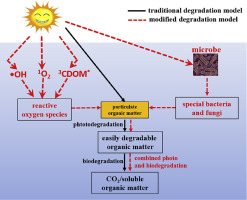Water Research ( IF 12.8 ) Pub Date : 2020-01-20 , DOI: 10.1016/j.watres.2020.115516 Na Song , He-Long Jiang

|
Eutrophication and climate warming cause macrophytes to spread rapidly in shallow lakes. The accumulation of excess decayed litter in lake water can improve the particulate organic matter content and lead to ecological deterioration. While decomposition of macrophyte litters in aquatic ecosystems is generally assumed to be biologically driven, photodegradation has been largely overlooked. In this study, the potential contribution of photodegradation to the decomposition of organic matter from macrophyte litter in a shallow lake was investigated under two types of light radiation: laboratory incubation light and natural solar radiation. Results showed that the combined photo- and biodegradation treatment removed more litter mass compared to solely photodegradation or biodegradation for over 108 days. More reactive oxygen species (ROS) were produced during litter degradation in lake water under the combined photo- and biodegradation treatments in comparison to other treatments. Removal efficiency of litter was doubled in the presence of ROS compared when ROS were captured. Additionally, NMR analysis revealed that lignin guaiacyl units were preferentially lost and the litter became more refractory under the combined photo oxidation and microbial degradation after 108 days. High-throughput sequencing analysis further indicated that solar irradiation stimulates the growth of bacteria (Treponema and Magnetospirillum) and fungi (Aspergillus) that have the ability to degrade aromatic compounds. Altogether, both ROS and specific microorganisms played important role in promoting litter degradation in lake water under light irradiation. Therefore, the role of solar radiation in particulate organic matter decomposition needs to be considered for a more accurate prediction of carbon dynamics in aquatic ecosystems.
中文翻译:

浅湖水中大型植物凋落物中有机物的协同光降解和生物降解:太阳辐射的双重作用
富营养化和气候变暖导致大型植物在浅湖中迅速扩散。湖泊水中过量腐烂的垃圾的积累可以提高颗粒有机物含量,并导致生态恶化。虽然一般认为水生生态系统中大型植物凋落物的分解是生物驱动的,但光降解却被很大程度上忽略了。在这项研究中,研究了在两种类型的光辐射下,光降解对浅湖大型植物凋落物中有机物分解的潜在贡献:实验室孵化光和自然太阳辐射。结果表明,与光降解或生物降解相比,光降解和生物降解相结合的处理在108天内清除了更多的垫料。与其他处理相比,在光降解和生物降解相结合的处理下,湖水中垃圾降解过程中会产生更多的活性氧(ROS)。与捕获ROS相比,在存在ROS的情况下,清除垃圾的效率提高了一倍。此外,NMR分析表明,木质素中的愈创木脂单元优先丢失,并且在108天后,由于光氧化和微生物降解的共同作用,凋落物变得更加难处理。高通量测序分析进一步表明,太阳辐射会刺激细菌的生长(NMR分析表明,木质素中的愈创木基单元会优先丢失,并且在经过108天的光氧化和微生物降解后,垫料变得更加难处理。高通量测序分析进一步表明,太阳辐射会刺激细菌的生长(NMR分析表明,木质素中的愈创木基单元会优先丢失,并且在经过108天的光氧化和微生物降解后,垫料变得更加难处理。高通量测序分析进一步表明,太阳辐射会刺激细菌的生长(能够降解芳香族化合物的螺旋体和磁螺旋体)和真菌(曲霉)。总而言之,ROS和特定微生物在光照射下促进湖水中凋落物降解方面都起着重要作用。因此,为了更准确地预测水生生态系统中的碳动力学,需要考虑太阳辐射在颗粒有机物分解中的作用。


























 京公网安备 11010802027423号
京公网安备 11010802027423号